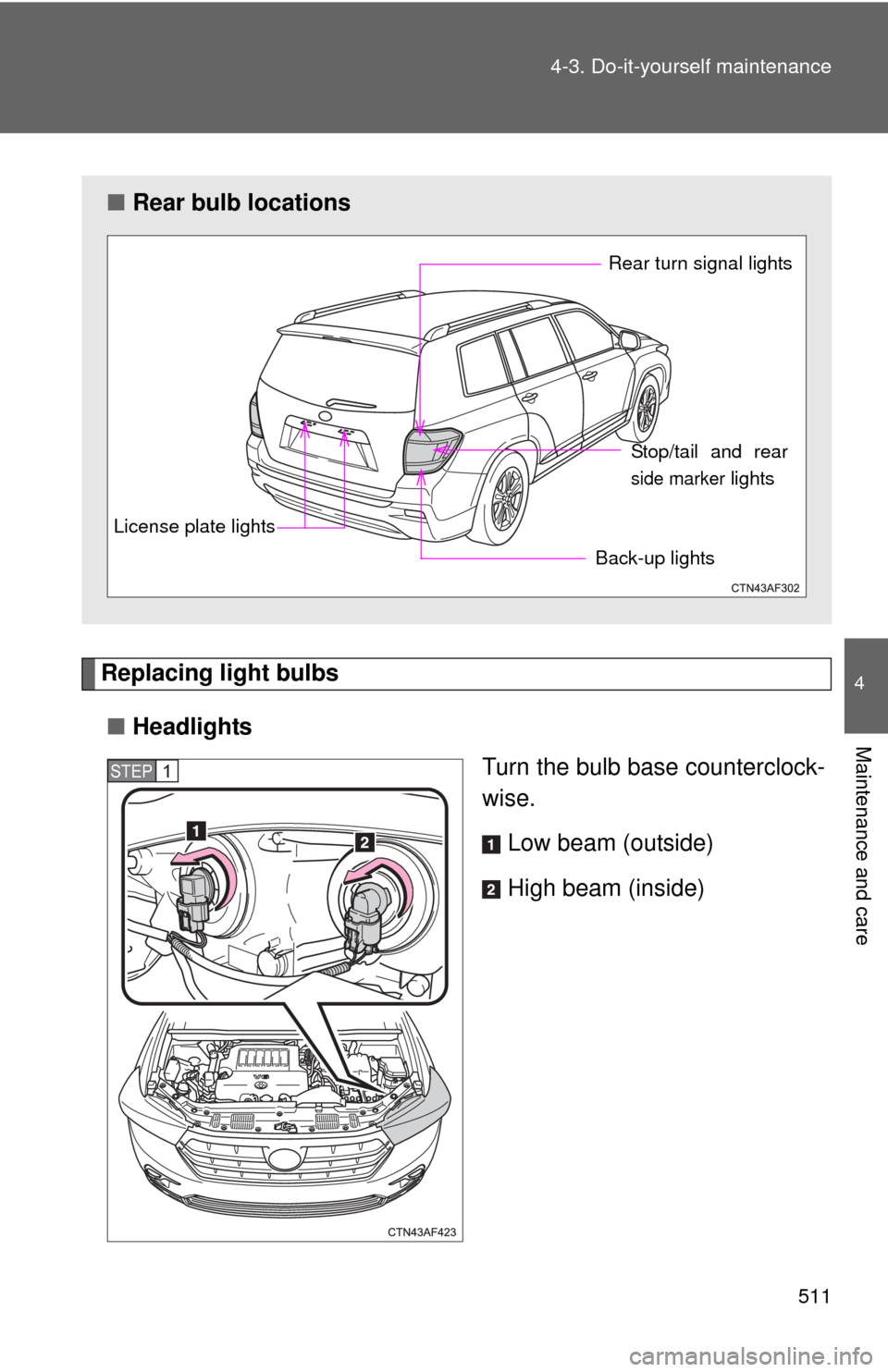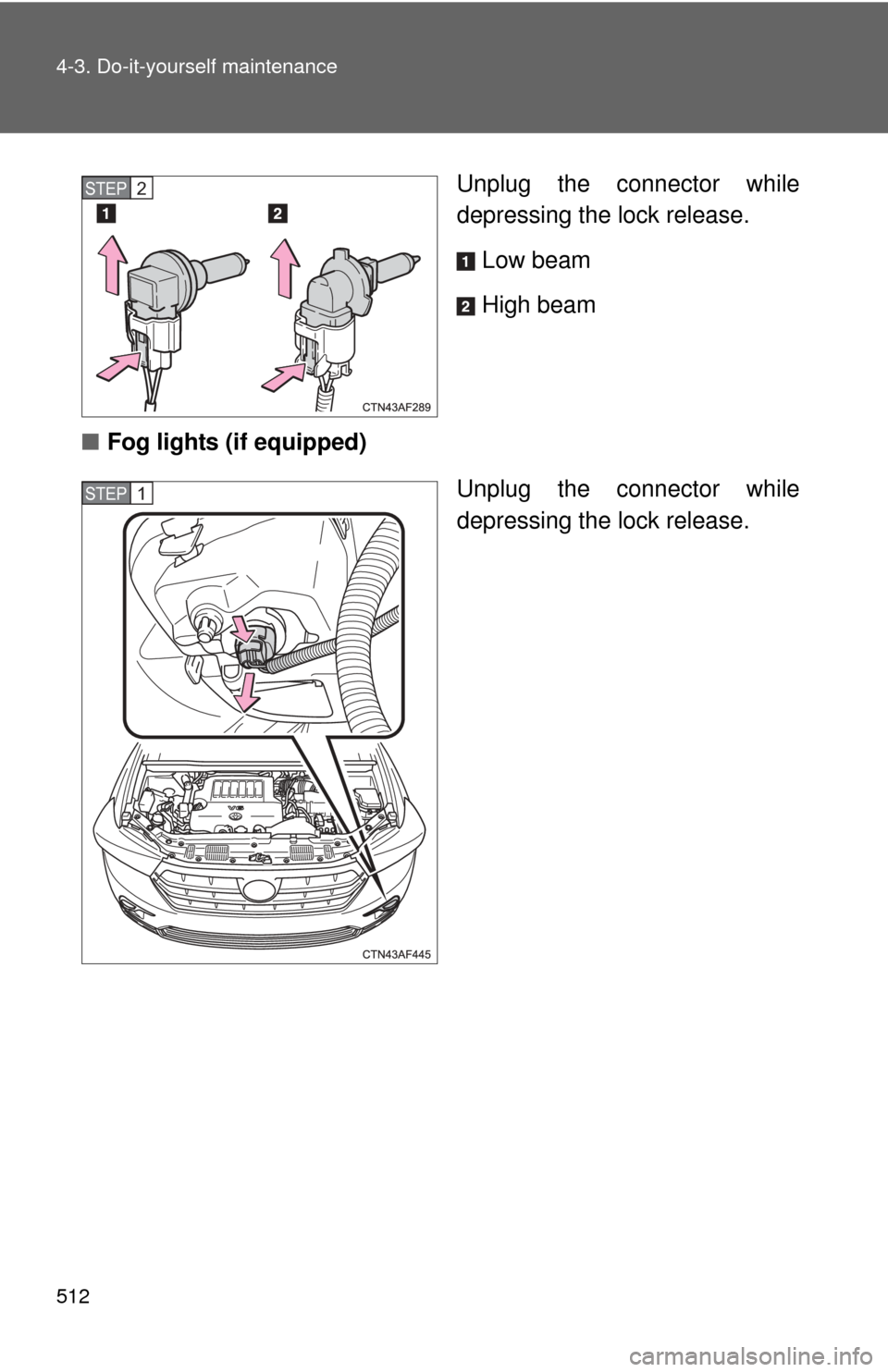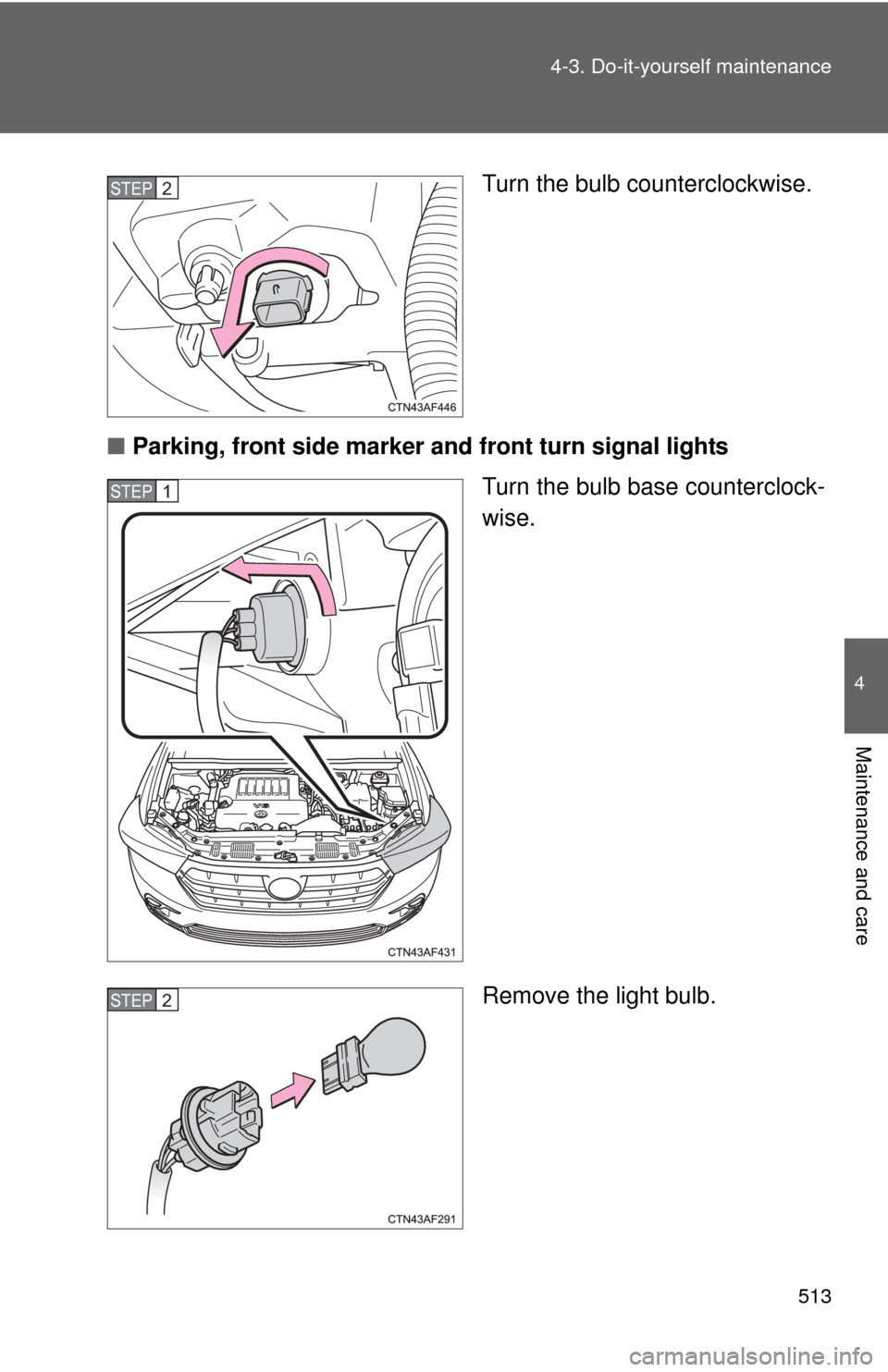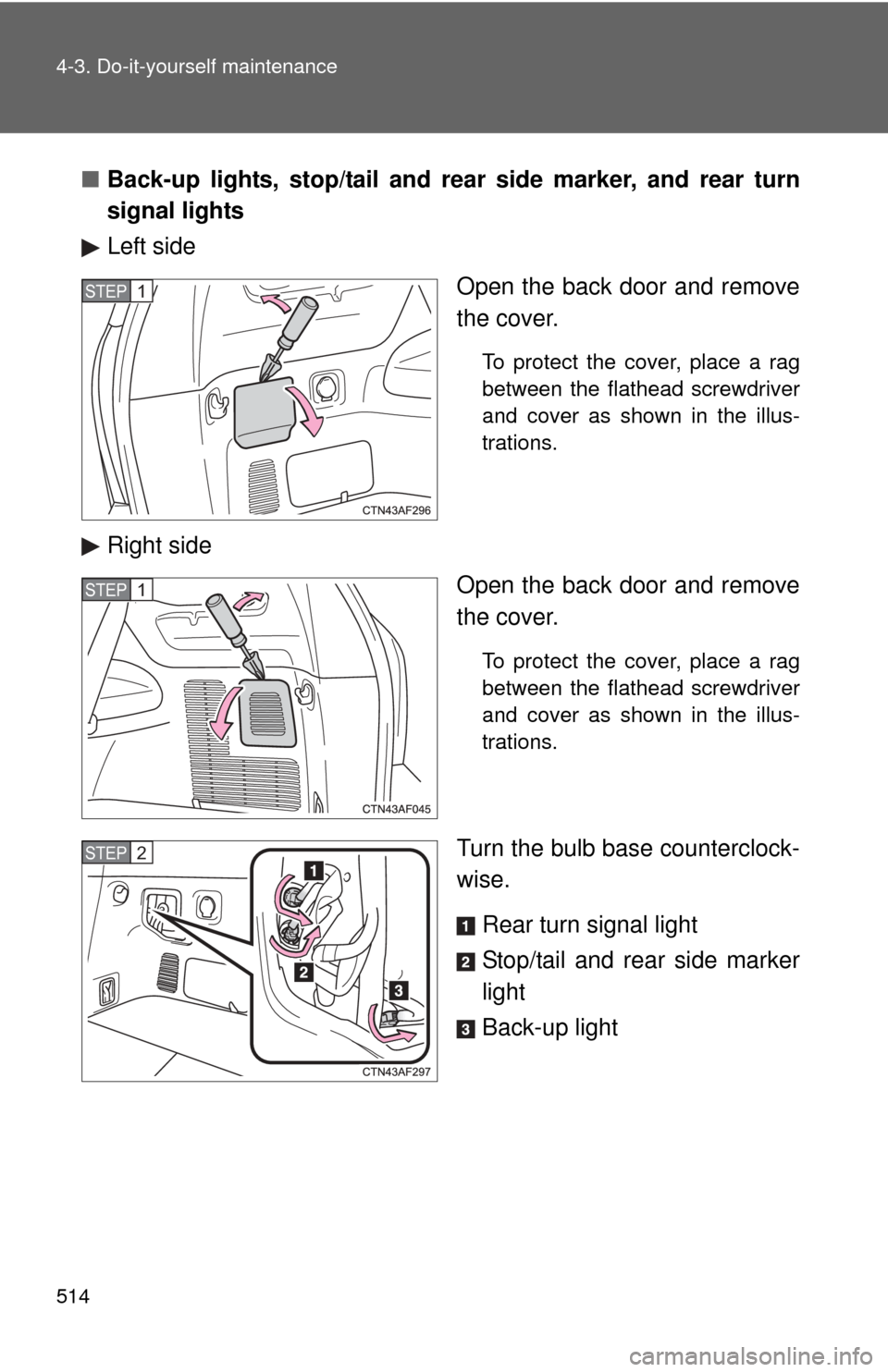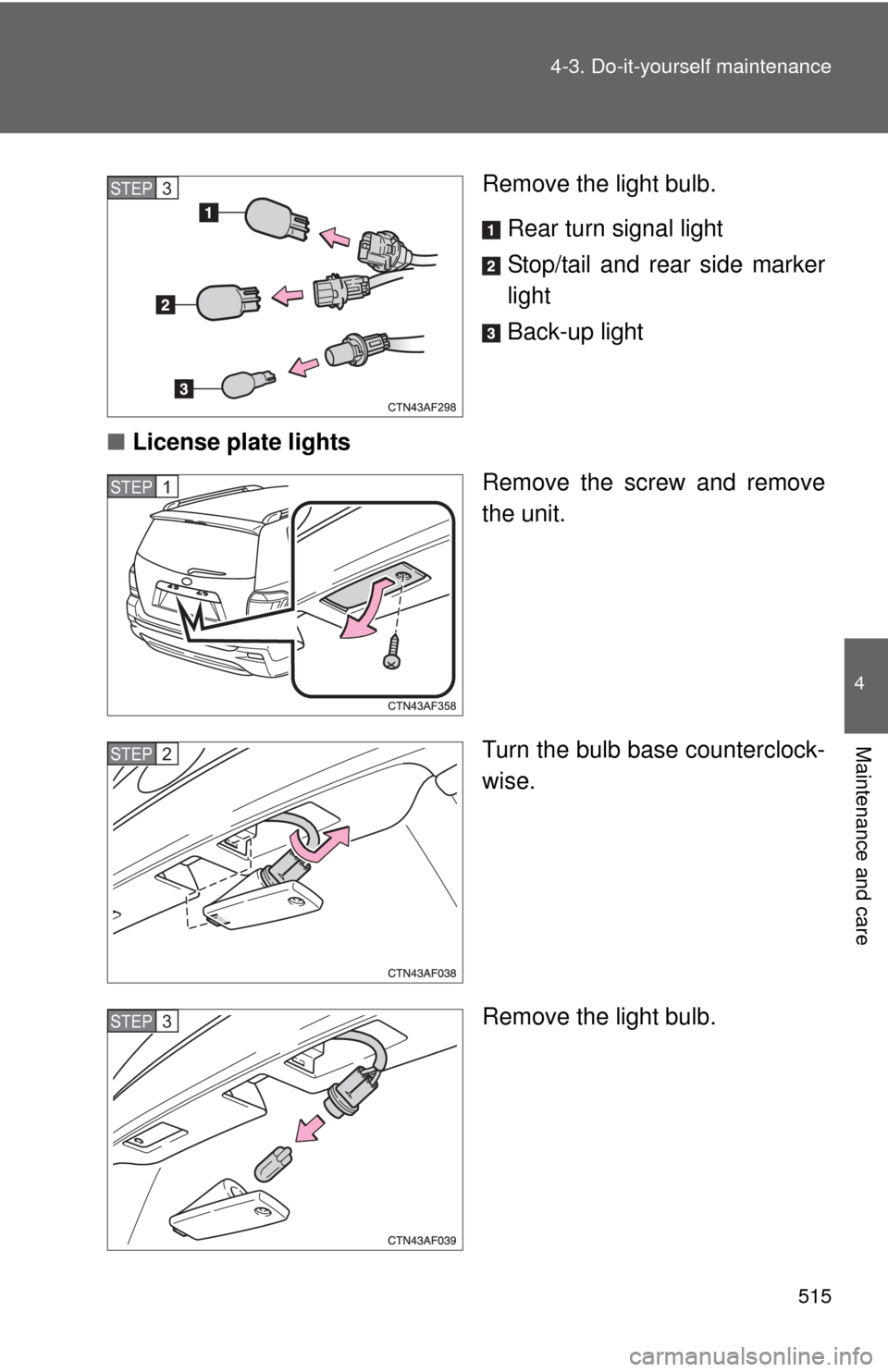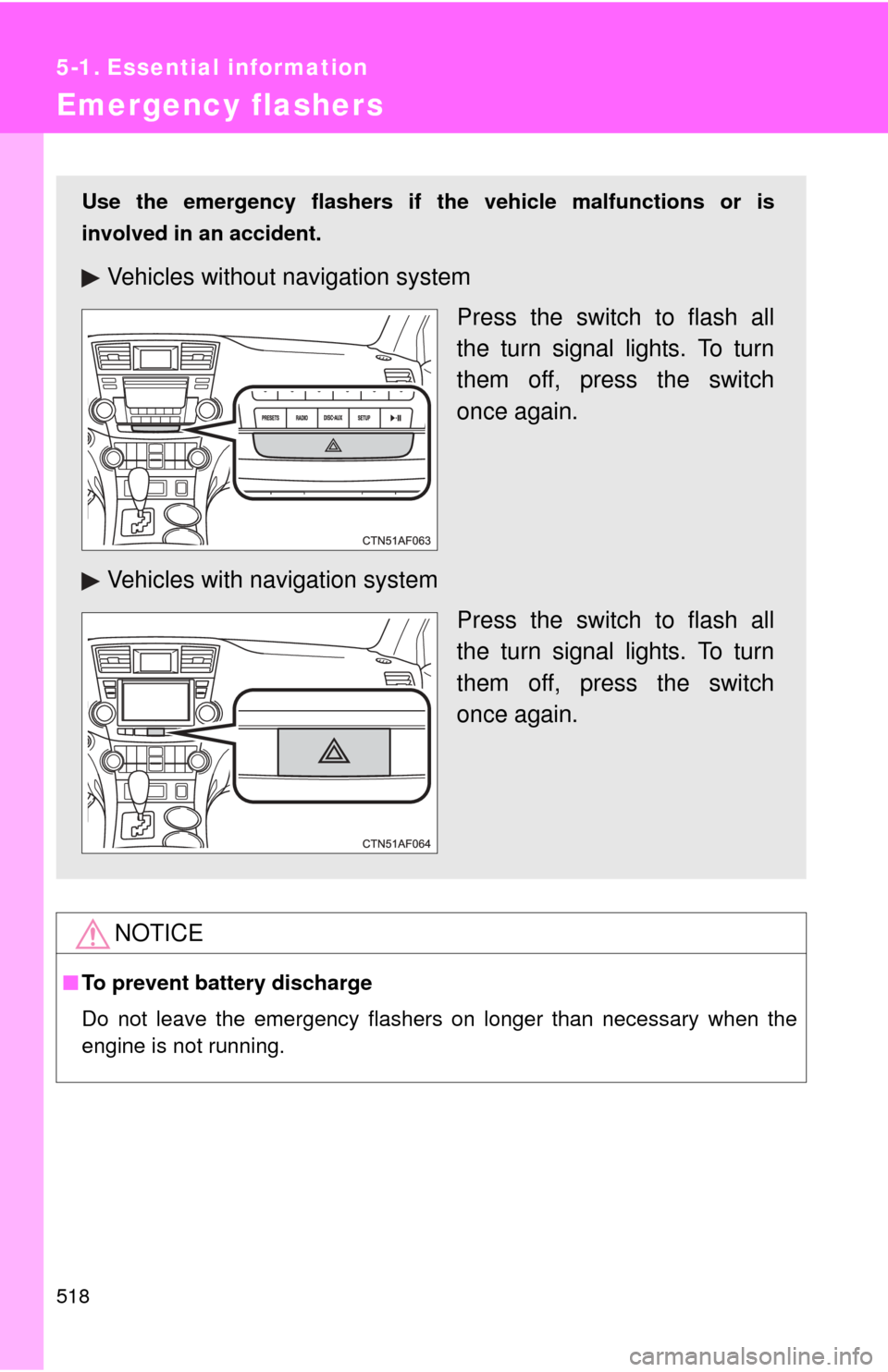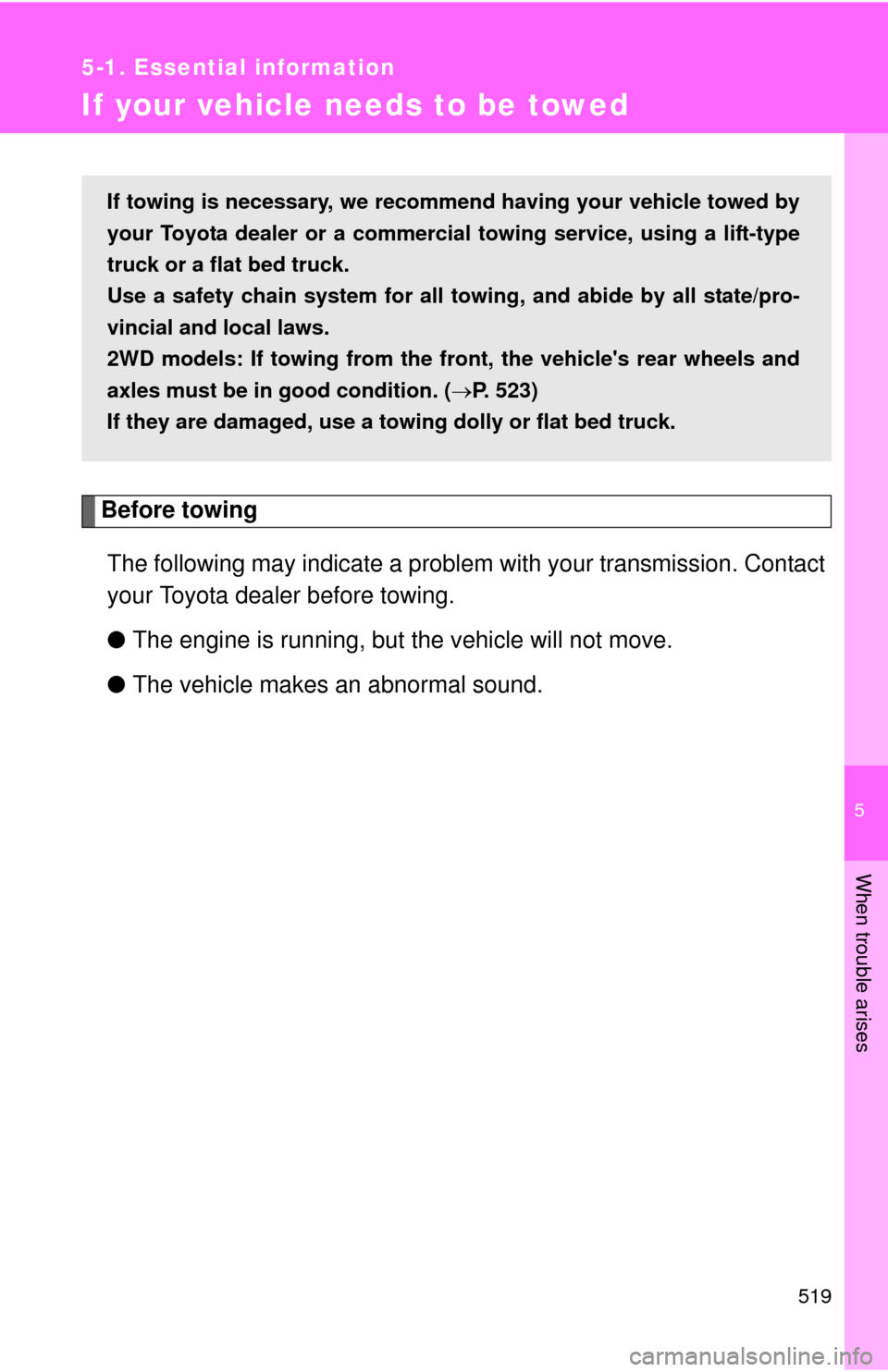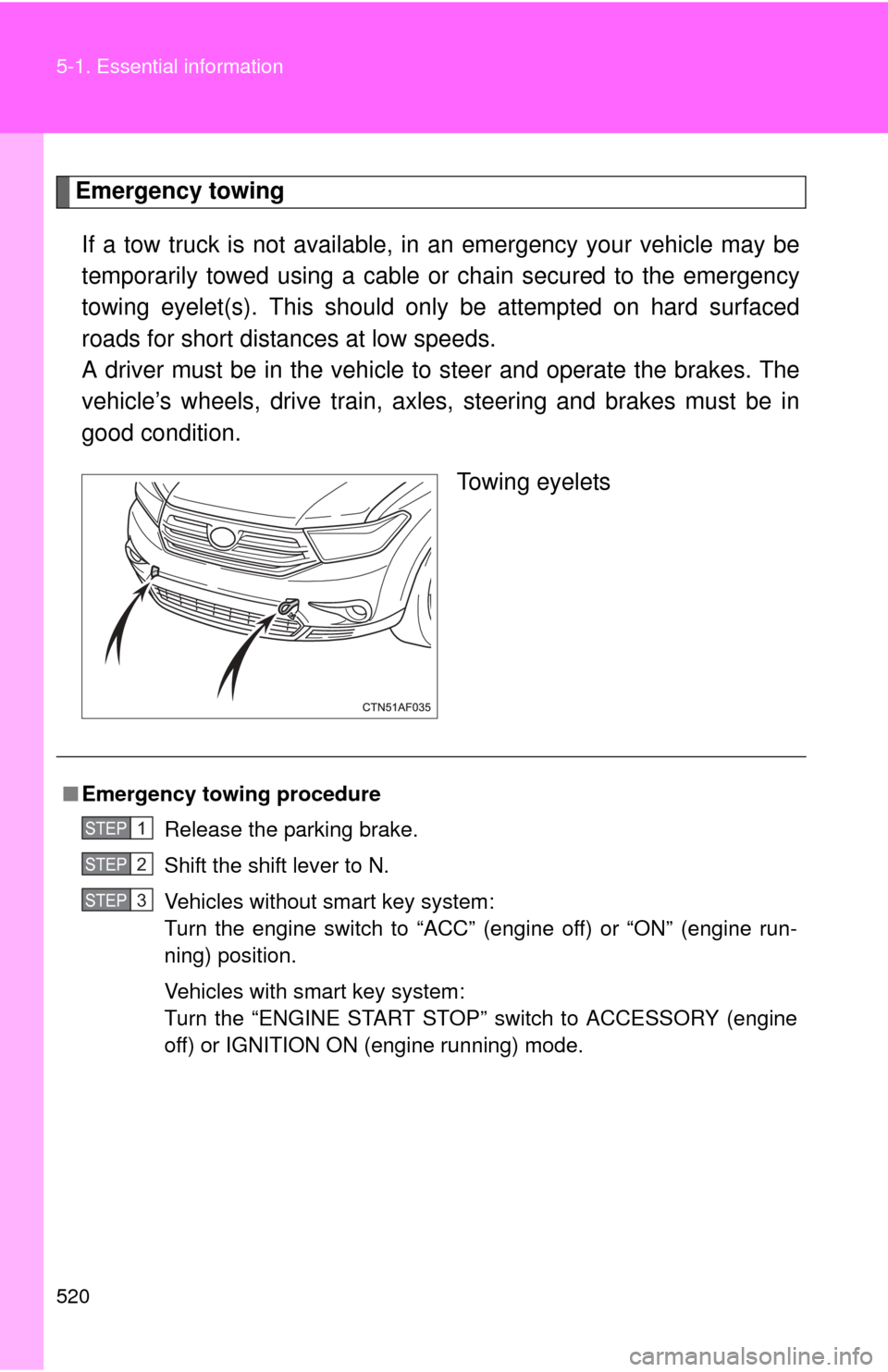TOYOTA HIGHLANDER 2012 XU40 / 2.G Owners Manual
HIGHLANDER 2012 XU40 / 2.G
TOYOTA
TOYOTA
https://www.carmanualsonline.info/img/14/6410/w960_6410-0.png
TOYOTA HIGHLANDER 2012 XU40 / 2.G Owners Manual
Trending: fold seats, roof, brake, deactivate airbag, wheel, height, water pump
Page 511 of 636
511
4-3. Do-it-yourself maintenance
4
Maintenance and care
Replacing light bulbs
■ Headlights
Turn the bulb base counterclock-
wise.
Low beam (outside)
High beam (inside)
■Rear bulb locations
Back-up lightsRear turn signal lights
Stop/tail and rear
side marker lights
License plate lights
STEP1
Page 512 of 636
512 4-3. Do-it-yourself maintenance
Unplug the connector while
depressing the lock release.Low beam
High beam
■ Fog lights (if equipped)
Unplug the connector while
depressing the lock release.STEP2
STEP1
Page 513 of 636
513
4-3. Do-it-yourself maintenance
4
Maintenance and care
Turn the bulb counterclockwise.
■ Parking, front side marker and front turn signal lights
Turn the bulb base counterclock-
wise.
Remove the light bulb.STEP2
STEP1
STEP2
Page 514 of 636
514 4-3. Do-it-yourself maintenance
■Back-up lights, stop/tail and rear side marker, and rear turn
signal lights
Left side
Open the back door and remove
the cover.
To protect the cover, place a rag
between the flathead screwdriver
and cover as shown in the illus-
trations.
Right sideOpen the back door and remove
the cover.
To protect the cover, place a rag
between the flathead screwdriver
and cover as shown in the illus-
trations.
Turn the bulb base counterclock-
wise.
Rear turn signal light
Stop/tail and rear side marker
light
Back-up light
STEP1
STEP1
STEP2
Page 515 of 636
515
4-3. Do-it-yourself maintenance
4
Maintenance and care
Remove the light bulb.
Rear turn signal light
Stop/tail and rear side marker
light
Back-up light
■ License plate lights
Remove the screw and remove
the unit.
Turn the bulb base counterclock-
wise.
Remove the light bulb.STEP3
STEP1
STEP2
STEP3
Page 516 of 636
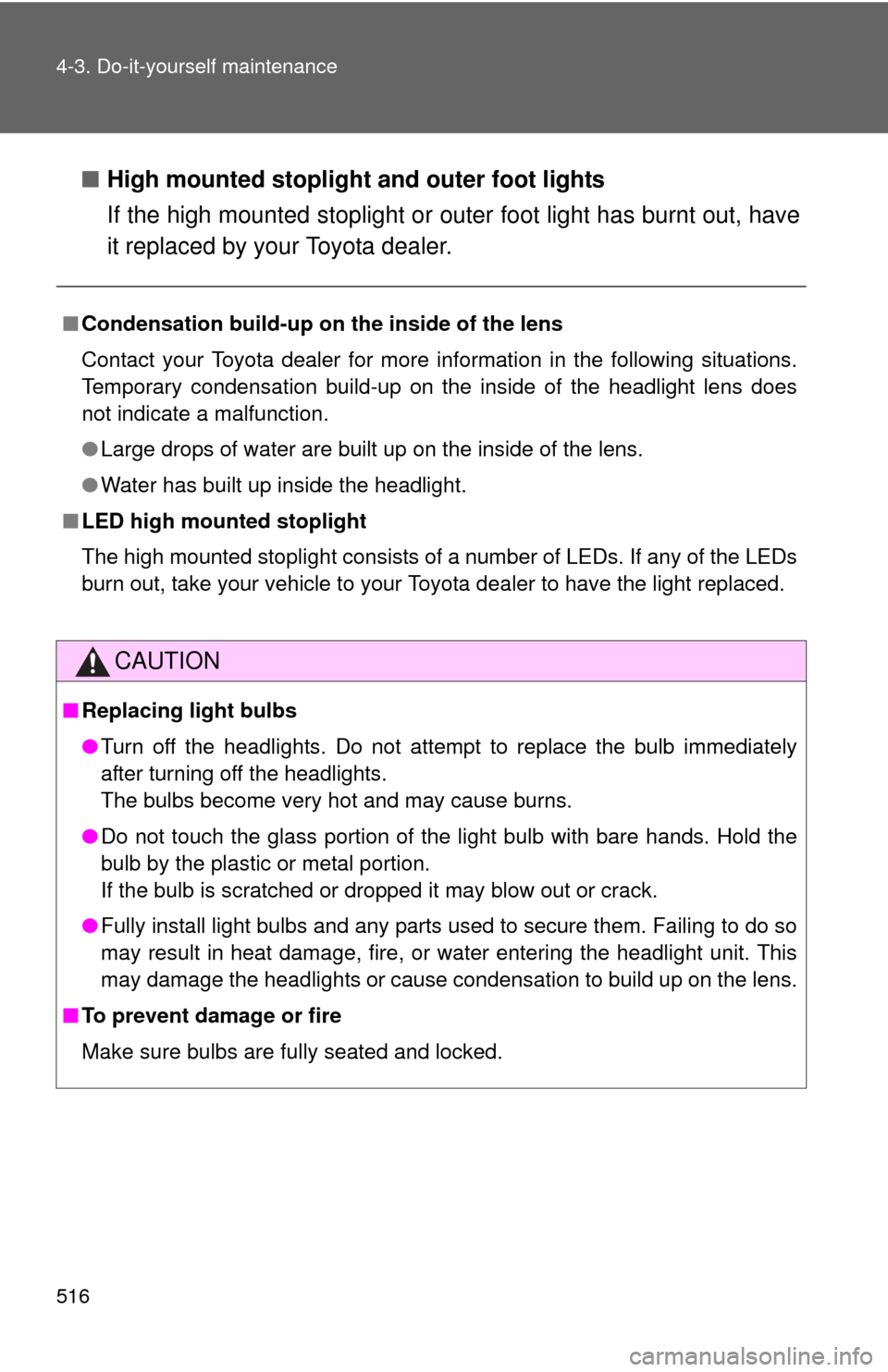
516 4-3. Do-it-yourself maintenance
■High mounted stoplight and outer foot lights
If the high mounted stoplight or outer foot light has burnt out, have
it replaced by your Toyota dealer.
■Condensation build-up on th e inside of the lens
Contact your Toyota dealer for more information in the following situations.
Temporary condensation build-up on the inside of the headlight lens does
not indicate a malfunction.
● Large drops of water are built up on the inside of the lens.
● Water has built up inside the headlight.
■ LED high mounted stoplight
The high mounted stoplight consists of a number of LEDs. If any of the LEDs
burn out, take your vehicle to your Toyota dealer to have the light replaced.
CAUTION
■Replacing light bulbs
●Turn off the headlights. Do not attempt to replace the bulb immediately
after turning off the headlights.
The bulbs become very hot and may cause burns.
● Do not touch the glass portion of the light bulb with bare hands. Hold the
bulb by the plastic or metal portion.
If the bulb is scratched or dropped it may blow out or crack.
● Fully install light bulbs and any parts used to secure them. Failing to do so
may result in heat damage, fire, or water entering the headlight unit. This
may damage the headlights or cause condensation to build up on the lens.
■ To prevent damage or fire
Make sure bulbs are fully seated and locked.
Page 517 of 636
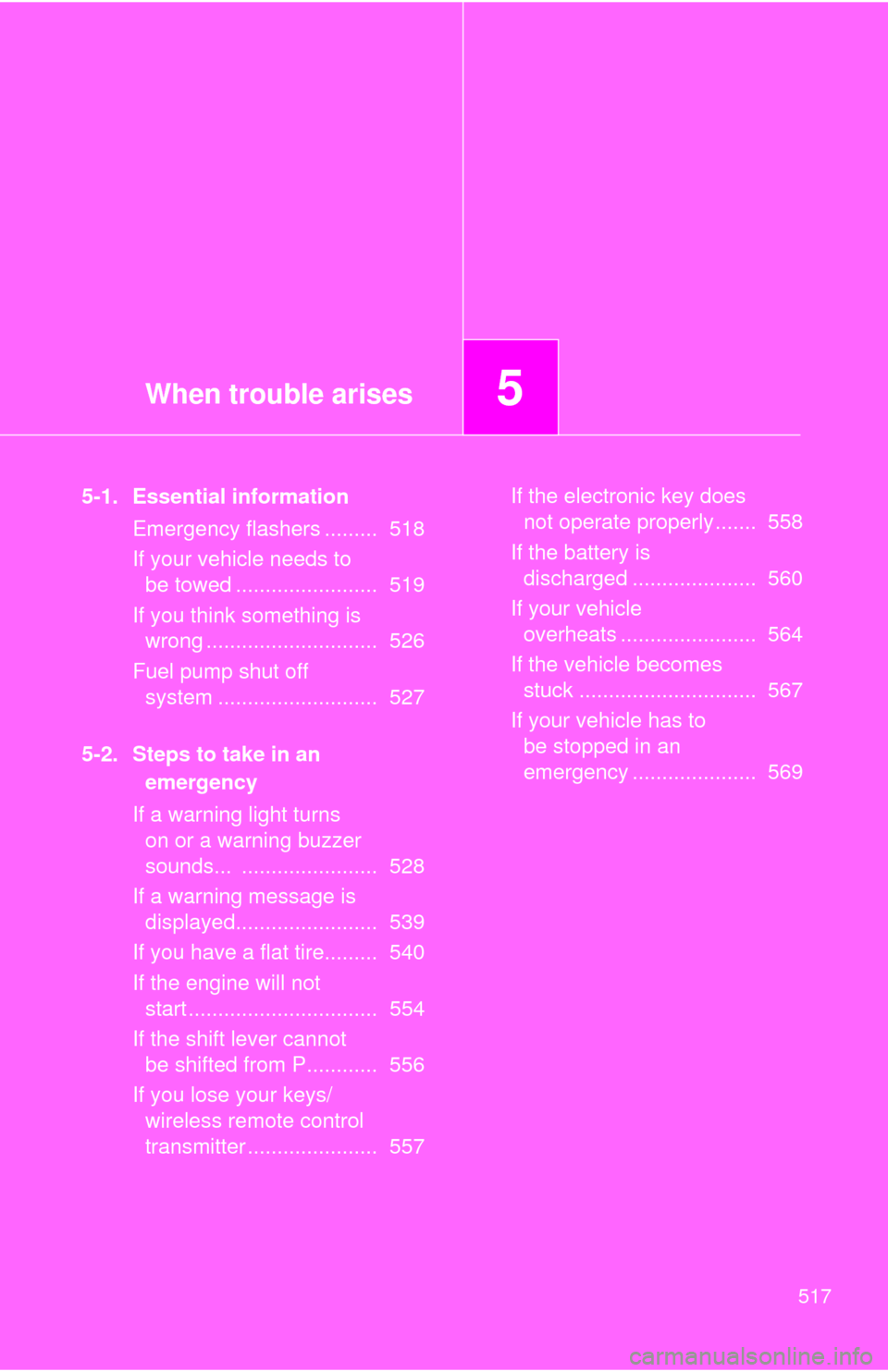
When trouble arises5
517
5-1. Essential informationEmergency flashers ......... 518
If your vehicle needs to be towed ........................ 519
If you think something is wrong ............................. 526
Fuel pump shut off system ........................... 527
5-2. Steps to take in an emergency
If a warning light turns on or a warning buzzer
sounds... ....................... 528
If a warning message is displayed........................ 539
If you have a flat tire......... 540
If the engine will not start ................................ 554
If the shift lever cannot be shifted from P............ 556
If you lose your keys/ wireless remote control
transmitter ...................... 557 If the electronic key does
not operate properly....... 558
If the battery is discharged ..................... 560
If your vehicle overheats ....................... 564
If the vehicle becomes stuck .............................. 567
If your vehicle has to be stopped in an
emergency ..................... 569
Page 518 of 636
518
5-1. Essential information
Emergency flashers
NOTICE
■To prevent battery discharge
Do not leave the emergency flashers on longer than necessary when the
engine is not running.
Use the emergency flashers if th e vehicle malfunctions or is
involved in an accident.
Vehicles without navigation system
Press the switch to flash all
the turn signal lights. To turn
them off, press the switch
once again.
Vehicles with navigation system Press the switch to flash all
the turn signal lights. To turn
them off, press the switch
once again.
Page 519 of 636
5
When trouble arises
519
5-1. Essential information
If your vehicle needs to be towed
Before towingThe following may indicate a problem with your transmission. Contact
your Toyota dealer before towing.
● The engine is running, but the vehicle will not move.
● The vehicle makes an abnormal sound.
If towing is necessary, we recommend having your vehicle towed by
your Toyota dealer or a commerci al towing service, using a lift-type
truck or a flat bed truck.
Use a safety chain system for all to wing, and abide by all state/pro-
vincial and local laws.
2WD models: If towing from the fr ont, the vehicle's rear wheels and
axles must be in good condition. (P. 523)
If they are damaged, use a towing dolly or flat bed truck.
Page 520 of 636
520 5-1. Essential information
Emergency towingIf a tow truck is not available, in an emergency your vehicle may be
temporarily towed using a cable or chain secured to the emergency
towing eyelet(s). This should only be attempted on hard surfaced
roads for short distances at low speeds.
A driver must be in the vehicle to steer and operate the brakes. The
vehicle’s wheels, drive train, axles, steering and brakes must be in
good condition.
Towing eyelets
■Emergency towin g procedure
Release the parking brake.
Shift the shift lever to N.
Vehicles without smart key system:
Turn the engine switch to “ACC” (engine off) or “ON” (engine run-
ning) position.
Vehicles with smart key system:
Turn the “ENGINE START STOP” switch to ACCESSORY (engine
off) or IGNITION ON (engine running) mode.
STEP1
STEP2
STEP3
Trending: open gas tank, brake pads, tire pressure reset, engine, door lock, change key battery, audio
